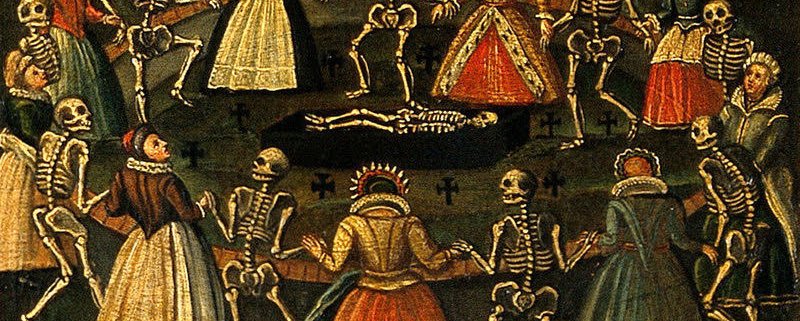Twelfth Night: A Plague on Both Your Houses
In the critical literature on Twelfth Night, as far as I can tell from a survey of reading lists and the titles and contents of books and articles, there is very little about the plague. Critics refer of course to Olivia’s comment that falling in love can be as quick as catching the plague; but they tend not to follow their comments through and mostly miss the extraordinary metaphor two lines later in which the perfections of the loved one with “an invisible and subtle stealth … creep in at mine eyes” (1.v.320-321) which picks up the Renaissance belief that the plague entered the body invisibly through the eyes.
And frankly this has never bothered me very much. Until now. The last year of the Coronavirus pandemic has shocked America. Since the civil war, no event on American soil has so threatened us. The virus took us unawares and has shaken our sense of what is real. We all have our different ways of describing the meaning and the practical implications of our experience of this modern version of the plague. But in most accounts I have read or heard, people talk about being unsettled, forced to do things we would rather not do, fearful of other people, fearful of the air, frightened to touch other people, scared of inanimate surfaces.
Shakespeare uses the imagery of the plague throughout his plays but he does not make much of it, or so it seems. None of the characters in his plays dies of the plague, nor do we have situations in which the plague features as a cause of illness or death. Yet we know that during his lifetime there were at least five major outbreaks; that his sister and his son Hamnet might have died from the plague; and we have the awful statistic that in 1603, not long after the first performance of this play, the plague killed about 20% of the population of London.
The plague did of course find its way into numerous pieces of literature. A favorite poem of mine by Thomas Nashe, his remarkable ‘A Litany in Time of Plague’, published in 1593, contains the following haunting lines:
Beauty is but a flower
Which wrinkles will devour;
Brightness falls from the air;
Queens have died young and fair;
Dust hath closed Helen’s eye.
I am sick, I must die.
Lord, have mercy on us!
To my mind these lines are echoed in Orsino’s 15-line sonnet which opens the first act of Twelfth Night.
The Elizabethan experience of the plague was a repetition of numerous outbreaks over the previous four centuries. The pinnacle of attrition was the Black Death, as the plague was called in medieval Europe, which came from Asia on ships that docked in 1347 in Messina in Sicily. In the next 5 years the plague killed about 20 million Europeans, that is approximately 33% of its population, and a similar percentage in North Africa. We have no real statistics for the death toll in Asia.
In The Decameron, probably written in the years of the Black Death and immediately afterwards, Giovanni Boccaccio wrote a series of stories (in a format that influenced Chaucer’s Canterbury Tales later in the century) in which a group of people took refuge from the plague in a villa outside of Florence in Italy. Their stories range from the erotic to the comnic. The first story is an account of the plague in Florence, which in its vividness gives us an idea of the shocking reality of the pandemic:
Almost at the beginning of springtime of the year in question, the plague began to show its sorrowful effects in an extraordinary manner. It did not assume the form it had in the East, where bleeding from the nose was a manifest sign of inevitable death, but rather showed its first signs in men and women alike by means of swellings either in the groin or under the armpits, some of which grew to the size of an ordinary apple and others to the size of an egg (more or less), and the people called them gavoccioli (buboes). And from the two parts of the body already mentioned, in very little time, the said deadly gavoccioli began to spread indiscriminately over every part of the body; then, after this, the symptoms of the illness changed to black or livid spots appearing on the arms and thighs, and on every part of the body – sometimes there were large ones and other times a number of little ones scattered all around. And just as the gavoccioli were originally, and still are, a very definite indication of impending death, in like manner these spots came to mean the same thing for whoever contracted them. (Translated by Mark Musa and Peter Bondanella, 1982)
Shakespeare probably read The Decameron. But he wouldn’t have needed to do so to know the deadly threat posed by the plague, which creeps into his plays from year to year as a silent and stealthy character. It’s the plague, or at least quarantine because of it, that prevents Friar John from delivering the key message in Romeo and Juliet. And we can name some of the plays that were written while theaters were closed due to the plague in London or immediately afterwards: King Lear, Macbeth, Antony and Cleopatra, Coriolanus and Timon of Athens. All of them are suffused with the threat or actuality of death by plague.
And there is no doubt in my mind that Twelfth Night is suffused with the attributes of the plague: the invisibility of its armor; its stealth and cunning; its speed; its looming and dying presence.
In the opening speech of Twelfth Night Orsino, caught up in his own self-indulgent indolence, speaks one of the most-quoted lines in Shakespeare: “If music be the food of love, play on….” and eight lines later, in this 15 line sonnet, he scoops up the theme again when he says, “O spirit of love, how quick and fresh art thou…”
Between these opening exclamations of love there is an immediate descent into darkness:
Give me excess of it, that surfeiting
The appetite may sicken and so die.
That strain again, it had a dying fall. (1,i,2-4)
Orsino’s musing is interrupted, or followed, by Curio’s return to the present. He asks if Orsino will be hunting the hart (by which he means pursuing the woman), to which Orsino has two replies. Firstly, he remembers the countess Olivia: “O, when my eyes did see Olivia first / Methought she purg’d the air of pestilence;” Secondly, he notes that his desire for Olivia, which immediately took command of him, had become his master: “And my desires, like fell and cruel hounds / E’er since pursue me.” (1,i,21-2)
Later, when Olivia falls in love with Viola in the guise of Cesario, she remarks on the speed with which she is caught up in the messy commerce of love:
How now?
Even so quickly may one catch the plague?
Methinks I feel this youth’s perfections
With an invisible and subtle stealth
To creep in at mine eyes … (1.v.317-321)
So desire is linked to the plague, which the Elizabethans thought might enter the body through the eyes, and the plague to death, and death to love. Every character, one way or another, is caught up in this web. In a key scene in which Viola plays the courtly lover of poetic sonneteering tradition, and Orsino the practical materialist of love, Orsino argues that men should choose younger women because “women are as roses, whose fair flower / Being once displayed doth fall that very hour.” To which Viola replies:
………. Alas that they are so
To die even when they to perfection grow. (2,iv,40-41)
Feste, that catalytic commentator on the mores of what’s going on around her, enters and sings her best known song:
Come away, come away death,
And in sad cypress let me be laid.
Fie away, fie away breath,
I am slain by a fair cruel maid.
And so, we can see, Twelfth Night is a play that is saturated in the pandemic that brought England, and indeed Europe, to its knees so many times over several centuries. When we telescope the play and distil the imagery of death and pestilence we get a sense of the pervasive ubiquity of the plague. And through the damp murk and mayhem of pestilence, love seeks to find an order of sanity, of uniting lovers, families and communities, that is like the return to a healthy reality after the epiphany that gives the play its title.
The themes that emerge from this play in performances and the critical literature need not be displaced by an emphasis on the imagery of death and pestilence that our own pandemic has fore-grounded. I’ll be talking about some of those in future blogs. But it’s worth while to give a few moments to thinking about how Shakespeare might have felt about the plague that threatened his life and his livelihood, that took away a third of his fellow Londoners a year after this play was first performed; and to imagine how the characters in Twelfth Night might have responded to this threat even in the relative sanctuary of an Illyrian Nova Scotia.




